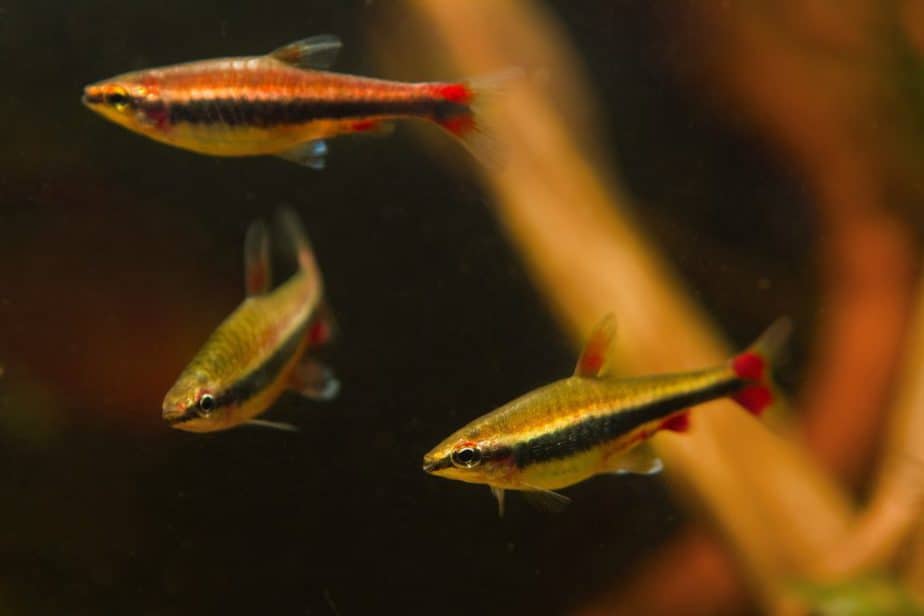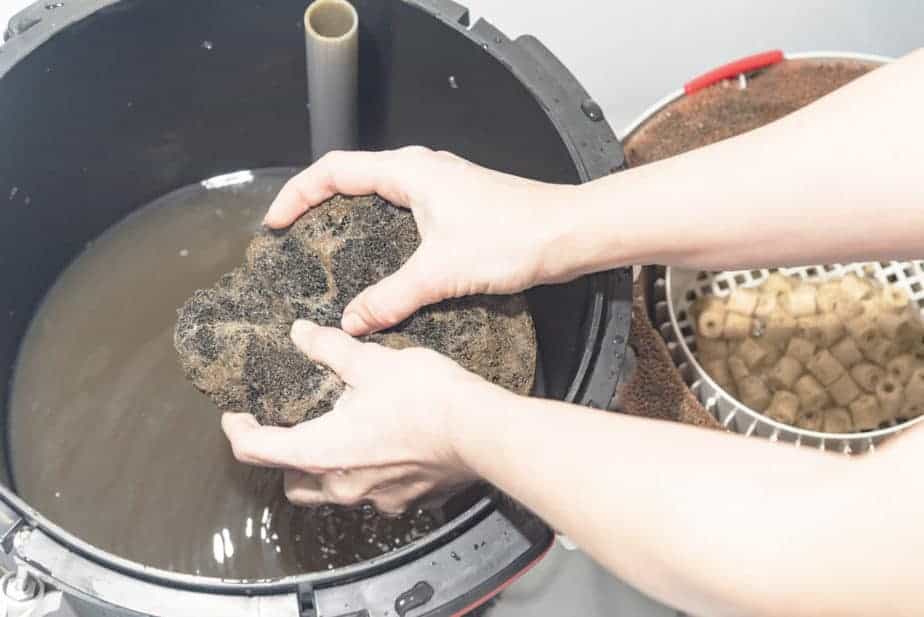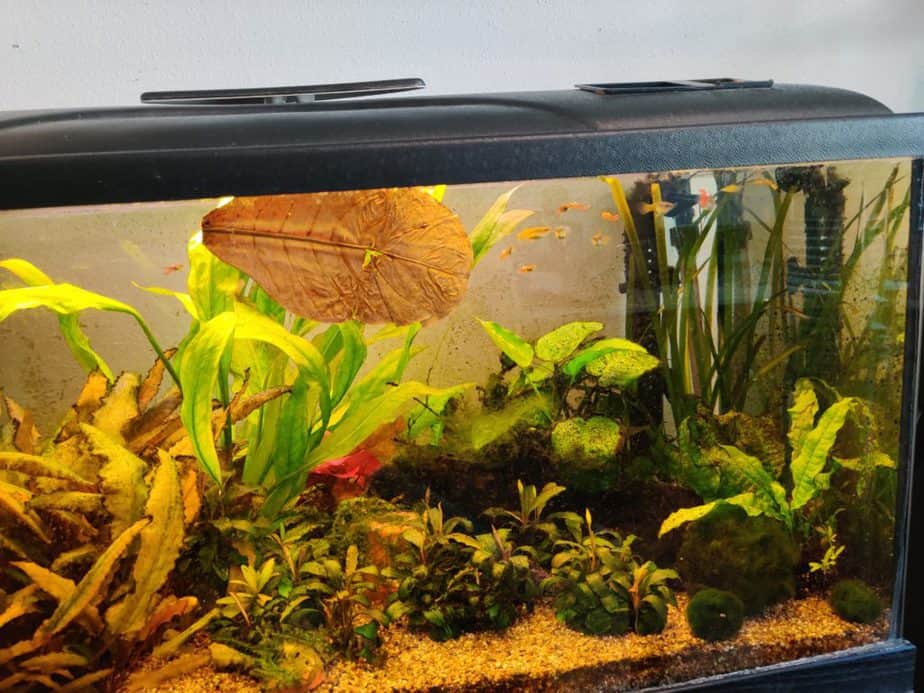How to Get Rid of Yellow Algae in Fish Tank
This post contains affiliate links. I make a small commission for a successful purchase at no extra expense to you.
If your aquarium water has turned yellow or brown, there could be something wrong with your tank. Typically, tank water is clear and without color. In some cases though, your aquarium water can become clouded and discolored.
Aquarium water can become yellow or brown due to tannins that leak out of driftwood or aquarium soil. Another reason could be rotting debris or blooming bacteria or other microorganisms. To solve this, check your water parameters, do a water change, or alter your filtration.
I will dig deep into this question throughout the course of this post. This way you can find out why your aquarium water has turned yellow or brown. I will also go over tips and solutions to fix your discolored water fast.
Your fish should be swimming in clear and healthy water. Keep reading to get the best information on this topic!
Reasons Your Aquarium Water Has Turned Yellow or Brown
1. Your Tank Is Infected With Bacteria or Other Microorganisms
Bacteria could be turning your tank water cloudy and discolored. When your tank is unclean or exposed to bacteria, an overgrowth can form in your aquarium. This is commonly referred to as a bacteria bloom.
However, while bacteria make tanks cloudy it doesn't cause them to turn yellow-looking. Other colors can appear in your tank. When your tank is yellow it is likely caused by a bloom of algae. Algae are micro-organisms that can taint your water and cause it to turn yellow. Algae are usually green but when they sit in the water they turn it yellow.
You don't want to ignore a potential bacteria or algae growth, especially if your tank is turning a cloudy yellow. Your tank could be cloudy because of bacteria, and yellow due to an abundance of waste and algae. Further grey discoloration could also be due to a bacteria bloom. So keep this in mind!
2. Your Water Has Tannins In It
Sometimes, brown or yellow water is not something to be worried about. Natural objects like driftwood or African leaves can actually release tannins in your tank water. Tannins are not harmful to your aquarium. They are a natural substance that discolors water and lowers the Ph of a tank.

In nature, tannins can discolor water and turn a fish habitat yellow or brown as well. The same thing happens in your tank with certain woods and plant material. You'll know if the color is due to tannins by looking at your water. If the water is not cloudy this is a good indication that tannins are to blame.
In fact, many people use almond leaves to manually lower the Ph and improve water conditions. If you want to read more about how to do this yourself, check out my easy guide on the matter over here.
In addition, check the other conditions of your water. If nitrites are not elevated, it is likely that your tank is in fine condition. In fact, some fish prefer darker colored water and thrive in these conditions. Just make sure that your fish is okay in softer water with lower Ph though.
3. Rotting Organic Material In Your Tank
Cloudy discolored water is a sign that your water has become heavily polluted. Organic materials like food, fish waste, plant waste, and other rotting substances can create a harmful environment for your pet.
A bad smell will usually accompany the yellow tinge of your aquarium. This is caused when tanks are filled with rotting material or have a heavy bioload. You will want to remedy these issues as soon as you can. Fish cannot survive long in this type of tank environment. They will get sick and die.
Again, this could be caused by a number of issues. Maybe your fish is producing a lot of waste and creates a concentrated and heavy bioload in your tank. Fish have to poop and pee like other pets. If you don't have a filter or don't clean up after you pet your water will change colors.
Alternatively, a lot of dead material can be floating in your tank and create problems.
For instance, if you have a planted tank, stray leaves and foliage could detach from your plants. If you don't get rid of them, they turn your water yellow or brown.
Plant material can seem harmless but if you don't get rid of it, you will cause harm to your pet and your tank water.
4. You Have Not Washed Your Substrate
New tanks are particularly prone to water problems. When you set up your aquarium, you might notice that your water is murky and yellow. This could be due to unwashed substrate. The substrate has dust and potential contaminants on it.
If you just put substrate in your tank, your water can turn a different color. You want to try and wash your substrate before placing it into a new aquarium. This way your water doesn't turn yellow or cloudy. In some cases, certain substrates might have tannins in them as well. So think about this as you set up your tank.
Your substrate might not be contaminated or harmful. But it's still good to give it a rinse so you can keep your tank water clean and safe!
Ways You Can Fix Your Discolored Aquarium Water
1. Check the Conditions of Your Water
Before you make any changes to your tank, you want to test your aquarium water. This is the easiest way to find out what is wrong with your water. Once you know what is causing the discoloration, you can take the right steps to treat your tank.
First, check nitrites, nitrate, ammonia, and Ph levels. These measurements will tell you if you have a waste problem in your tank. And if this is the case, you will probably want to fix your water chemistry with a partial water change.
In addition, look at the water and see if there is a lot of floating debris. Floating material can also be a culprit of yellow or brown water. If you have dead plants, old food, or other particles floating around they could be causing issues. Nothing should be left to rot in your tank!
Furthermore, if your tank is big enough, you might even have a dead fish that is hidden away and rotting. This will cause water problems. Make sure to thoroughly look at your aquarium from all angles.
2. Get A Filter or Make Sure Yours is Running Right
A good aquarium filter will keep your water clear and colorless. Waste and other contaminants build when you don't have a filtering device in your tank.
You might already have a filter though. If this is the case, you want to make sure that it works properly. If your device is malfunctioning, your tank won't stay clean and clear. And if you have a device that isn't suited for your tank size you will run into water quality issues.

When you notice that your tank is turning yellow or brown, make sure to check on your filter. Ensure it works right and is the correct fit for your tank. Also, try changing your filter cartridge if it has been in too long.
Filters can get dirty over time. The cartridges need to be removed routinely and replaced with a fresh one. While you are doing this, check for any clogging or debris in your filter. This could be slowing your filter down and causing your tank to become more toxic.
3. Pre-rinse Wood and Substrate
If tannins are causing your water to become brown or yellow looking, you don't necessarily have to do anything to "fix" your tank. However, not everyone will like having a darker looking tank. You could just take your driftwood out of your tank. But if you do not want to do that, there are other options.
Tannins eventually run out in a piece of wood. If you want you can try rinsing your wood before it goes in the water. This will take out some of the tannins and make your water less colored. Still, if you don't want any discoloration at all, try soaking all the tannins out in a bowl.
All you have to do is get a bowl with warm water and leave your driftwood in. By the next day, the tannins will be leeched out. This way you can put your driftwood into your tank again without turning the water yellow or brown.
Tannins can also be found in certain substrates as well. I recommend rinsing your substrate. Your water is less likely to turn yellow or brown with this method.
4. Perform A Water Change
A water change will clear up your water in an effective manner. Especially if waste is causing your tank to rot and turn yellow or brown. Contaminants are likely filling your tank, so you want to perform a big water change.
A 40 percent water change will bring you the best results. This will help bring the concentration of nitrites and other toxins down. But you want to do this step carefully and have new and clean water prepared for your aquarium.
Your fish is already stressed out by their filthy aquarium environment. Make sure the conditions of your new water are suited to your pet. The climate of your tank should not be drastically changed by your water change.
5. Get Rid of Rotting Materials
In addition to doing a water change, you will need to get rid of any floating debris in your water. A water change is not enough. If you don't take out organic material rotting in your tank your new water will get infected and turn your aquarium yellow again.
Get rid of anything that is rotting or could rot. This includes dead plants, dead pets, and bits of food. You can also do some light cleaning in your tank.
6. Keep Up with Tank Maintenance
You want to create a cleaning routine for your tank. You could do a more thorough cleaning every month. But this will just create more work for you.
There are many devices and tools you can use to maintain your aquarium with ease. A gravel vacuum is one item you should invest in. It sucks up waste at the bottom of a tank fast. It's also helpful when you are performing a water change.
Water changes are annoying, but they need to be done every week or two. This depends on the size of your tank though. Also, consider getting rid of growing algae with a razor or scrubber when you see it blooming.
Again, Algae is a common source of water discoloration. Nip this problem at the bud and get rid of this micro-organism when it crops up.
Really, you want to be maintaining your tank with light cleaning on a regular basis. This way waste doesn't build up and cause issues for your aquarium. If you stay on top of the appearance of your aquarium it is less likely to change color, to begin with.

Cautions to Take When Cleaning Your Tank
A water change and tank cleaning are the perfect way to get your tank healthy again. But If you decide to do a full cleaning of your tank, you need to take some precautions. It is good to clean your tank, but your fish and water are sensitive to slight changes.
You want to take your time cleaning your aquarium. So do not rush the process. Cleaning everything in your tank all in one day can cause further issues. For instance, you don't want to clean your filter and do a water change on the same day. This could disturb the beneficial bacteria colonies in your aquarium.
Beneficial bacteria are also found in your gravel as well. You can do a water change the same day you clean up your substrate. But I recommend waiting a week before you do anything to your filter.
You might find this frustrating and time-consuming. But you want your fish to be healthy. And you want your water to improve. Stick to these tips for optimal results!
My Favorite Fishtank Products to Make Life Easier
Over the years I've found a variety of products that make the fish keeping life so much easier. Whenever someone asks me what products I recommend buying, these are the first 5 items that come to mind. I'll briefly list them below and state why I love them so much. I'm 100% sure you'll love them!
1. A good gravel vacuum; Without a gravel vacuum, cleaning the substrate of your tanks is near impossible. Whenever I want to remove some of the sunken detritus from the bottom of my tank I'm happy I've got one of these. They're available here on Amazon and I highly recommend them!
2. Liquid plant fertilizer; It's no secret that I do not like nutritious aqua-soil. It makes a mess and only works a given amount of time. Instead, I always use a liquid aquarium plant fertilizer. Everyone who keeps live plants needs it, it's not that expensive and makes your plants grow better. This is the one I use and recommend.
If your plants are rooted in gravel or sand, it's best to add root tabs. These tablets create all nutrients your plants need and need to be replaced once per 3 months. I use the Flourish Tabs from Seachem, which are available here.
3. A set of aquascape tools; I love keeping plants, but planting and reorganizing my aquarium was difficult until I got a set of these tools. It's much easier to plant any kind of plant compared to using my thick fingers. They're also available here on Amazon.
4. A liquid-based water test kit; ever since I'm able to accurately test my water parameters, keeping fish became less stressful. Before I was always stressed that my water parameters were wrong, but using a kit such as the API Master kit, which is available here, I can measure this. It really is essential to successful fishkeeping.
5. A digital thermometer; the more you know about your aquarium, the better! Temperature is crucial for the health of your fish. A thermometer will also show you whether your heaters are still working correctly. It will give you more insight and more peace of mind. It's available here on Amazon, you will not be disappointed!
How to Get Rid of Yellow Algae in Fish Tank
Source: https://aquariumgenius.com/why-your-aquarium-water-is-yellow-or-brown-and-how-to-fix-it/